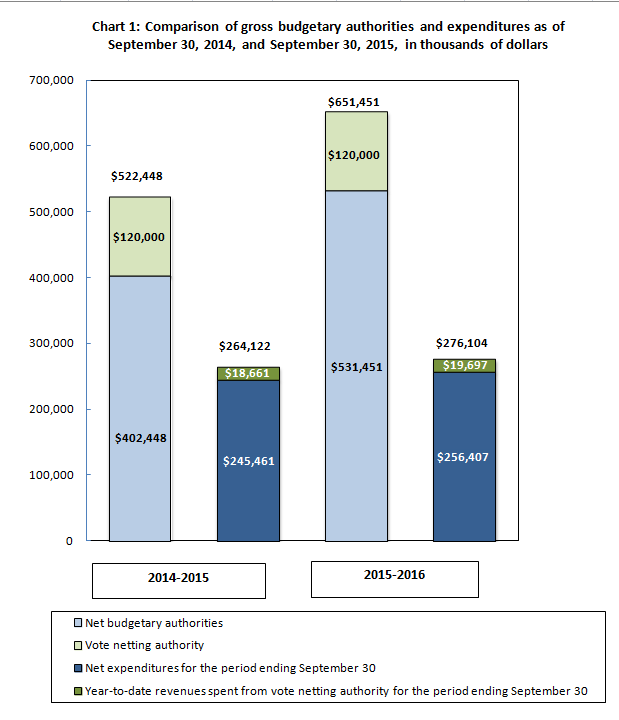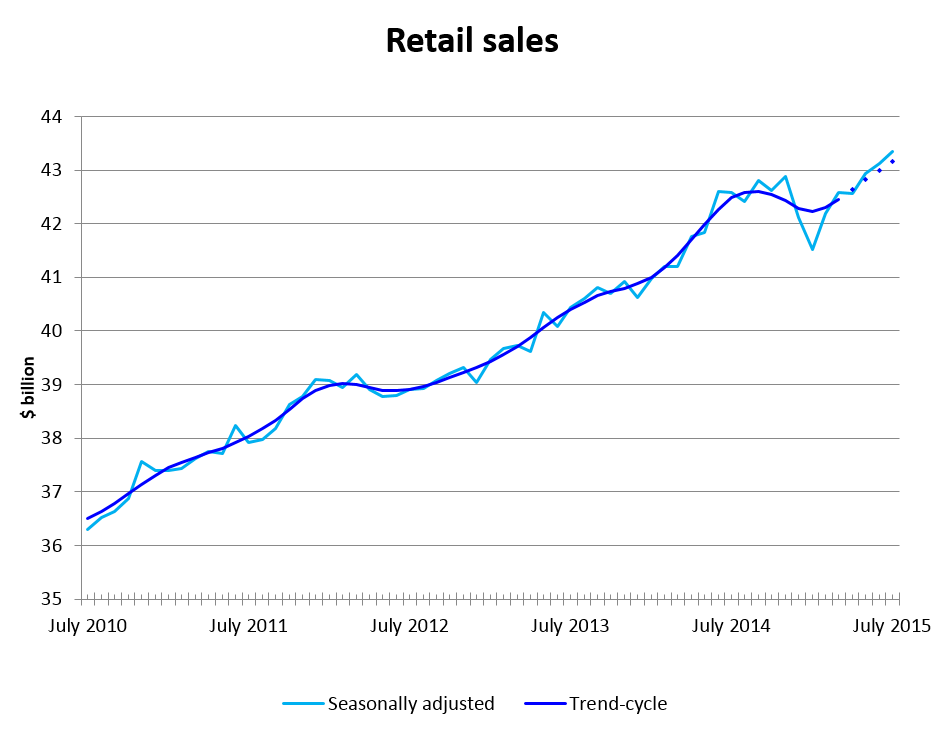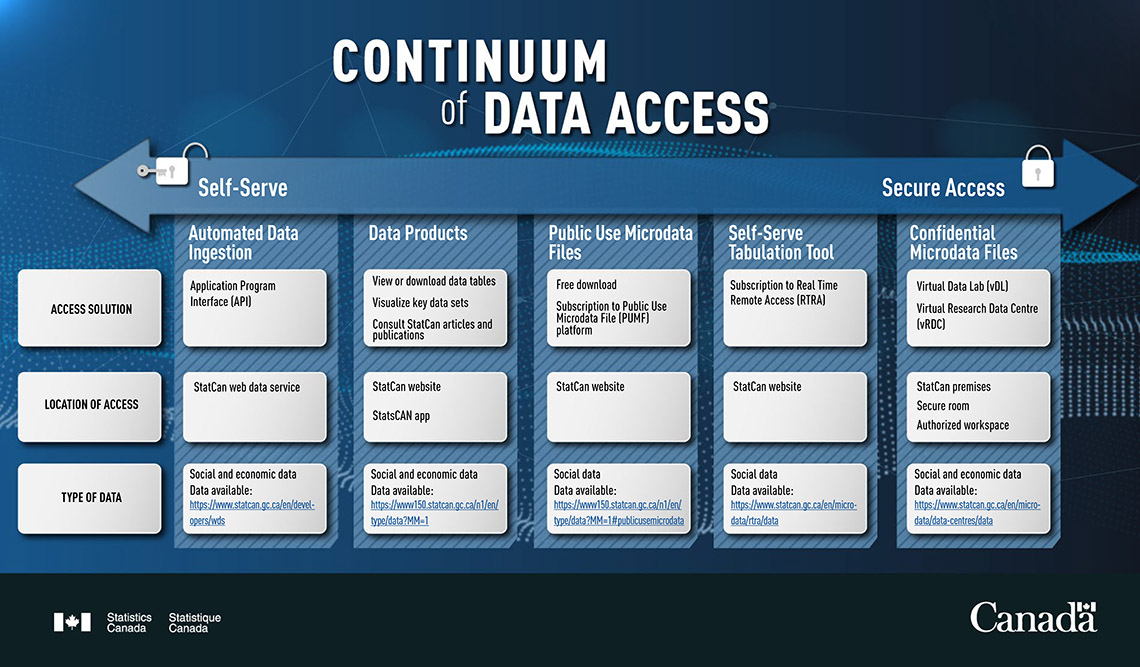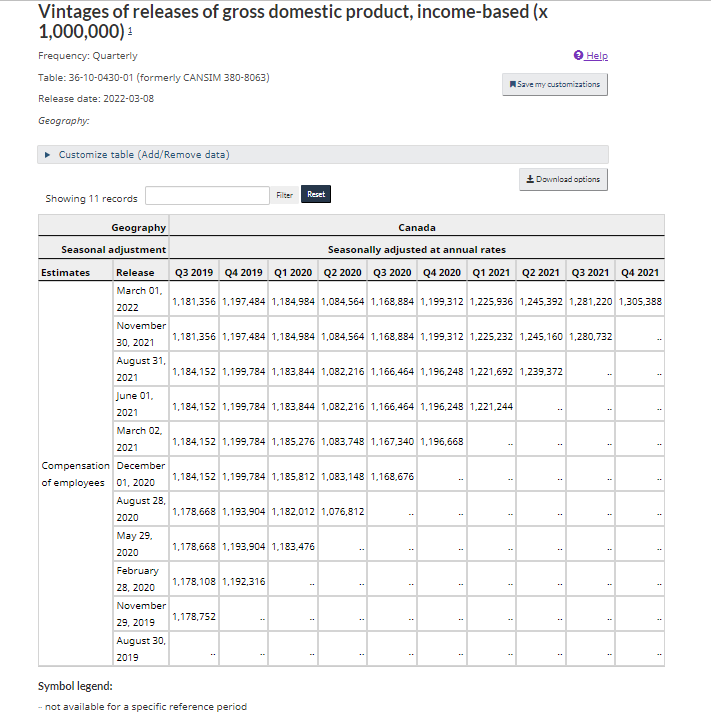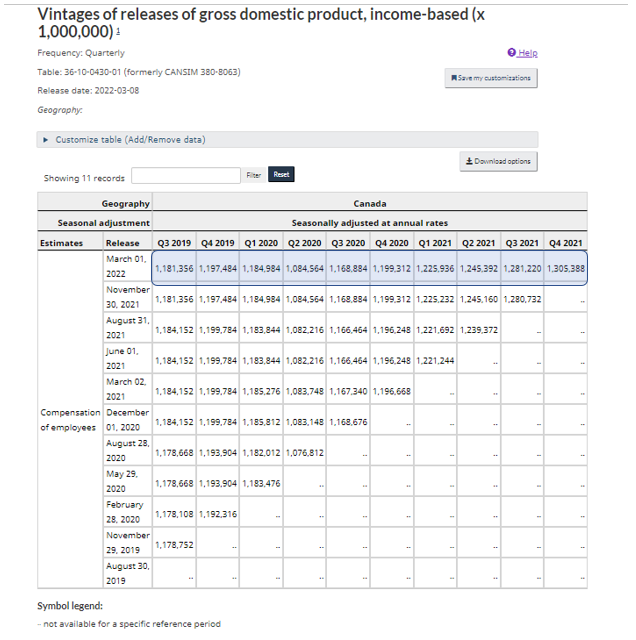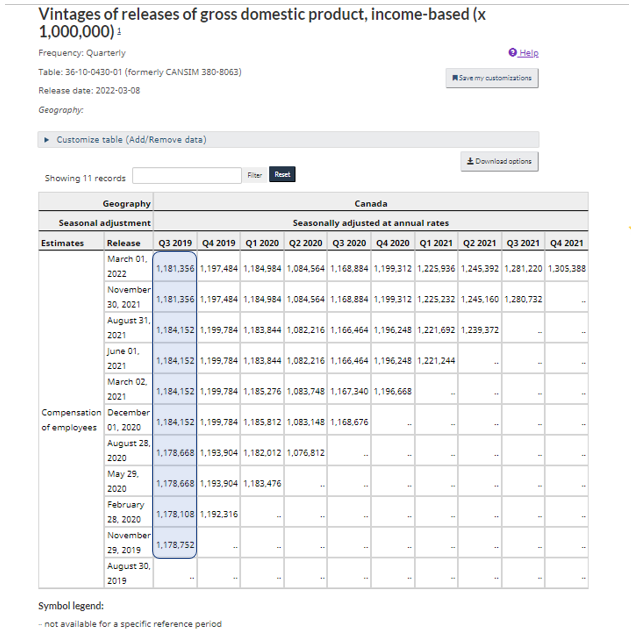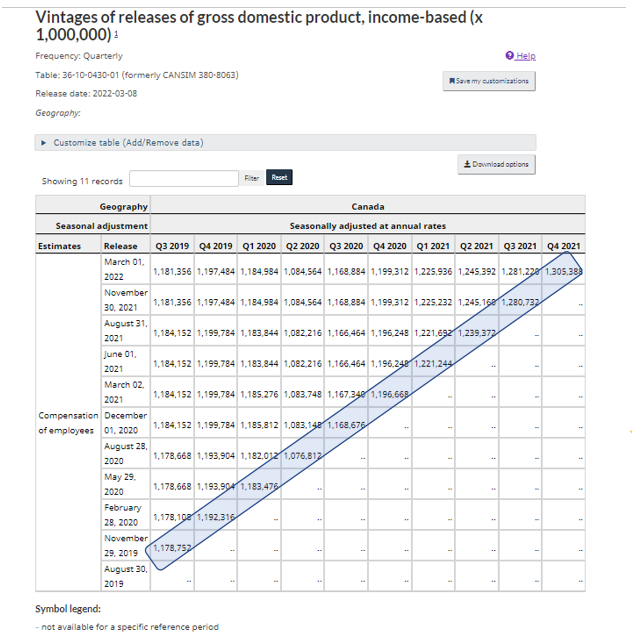The Monthly Survey of Manufacturing (MSM) publishes statistical series for manufacturers – sales of goods manufactured, inventories, unfilled orders and new orders. The values of these characteristics represent current monthly estimates of the more complete Annual Survey of Manufactures and Logging (ASML) data.
The MSM is a sample survey of approximately 10,500 Canadian manufacturing establishments, which are categorized into over 220 industries. Industries are classified according to the 2012 North American Industrial Classification System (NAICS). Seasonally adjusted series are available for the main aggregates.
An establishment comprises the smallest manufacturing unit capable of reporting the variables of interest. Data collected by the MSM provides a current ‘snapshot’ of sales of goods manufactured values by the Canadian manufacturing sector, enabling analysis of the state of the Canadian economy, as well as the health of specific industries in the short- to medium-term. The information is used by both private and public sectors including Statistics Canada, federal and provincial governments, business and trade entities, international and domestic non-governmental organizations, consultants, the business press and private citizens. The data are used for analyzing market share, trends, corporate benchmarking, policy analysis, program development, tax policy and trade policy.
1. Sales of goods manufactured
Sales of goods manufactured (formerly shipments of goods manufactured) are defined as the value of goods manufactured by establishments that have been shipped to a customer. Sales of goods manufactured exclude any wholesaling activity, and any revenues from the rental of equipment or the sale of electricity. Note that in practice, some respondents report financial transactions rather than payments for work done. Sales of goods manufactured are available by 3-digit NAICS, for Canada and broken down by province.
For the aerospace product and parts, and shipbuilding industries, the value of production is used instead of sales of goods manufactured. This value is calculated by adjusting monthly sales of goods manufactured by the monthly change in inventories of goods / work in process and finished goods manufactured. Inventories of raw materials and components are not included in the calculation since production tries to measure "work done" during the month. This is done in order to reduce distortions caused by the sales of goods manufactured of high value items as completed sales.
2. Inventories
Measurement of component values of inventory is important for economic studies as well as for derivation of production values. Respondents are asked to report their book values (at cost) of raw materials and components, any goods / work in process, and finished goods manufactured inventories separately. In some cases, respondents estimate a total inventory figure, which is allocated on the basis of proportions reported on the ASML. Inventory levels are calculated on a Canada‑wide basis, not by province.
3. Orders
a) Unfilled Orders
Unfilled orders represent a backlog or stock of orders that will generate future sales of goods manufactured assuming that they are not cancelled. As with inventories, unfilled orders and new orders levels are calculated on a Canada‑wide basis, not by province.
The MSM produces estimates for unfilled orders for all industries except for those industries where orders are customarily filled from stocks on hand and order books are not generally maintained. In the case of the aircraft companies, options to purchase are not treated as orders until they are entered into the accounting system.
b) New Orders
New orders represent current demand for manufactured products. Estimates of new orders are derived from sales of goods manufactured and unfilled orders data. All sales of goods manufactured within a month result from either an order received during the month or at some earlier time. New orders can be calculated as the sum of sales of goods manufactured adjusted for the monthly change in unfilled orders.
4. Non-Durable / Durable goods
a) Non-durable goods industries include:
Food (NAICS 311),
Beverage and Tobacco Products (312),
Textile Mills (313),
Textile Product Mills (314),
Clothing (315),
Leather and Allied Products (316),
Paper (322),
Printing and Related Support Activities (323),
Petroleum and Coal Products (324),
Chemicals (325) and
Plastic and Rubber Products (326).
b) Durable goods industries include:
Wood Products (NAICS 321),
Non-Metallic Mineral Products (327),
Primary Metals (331),
Fabricated Metal Products (332),
Machinery (333),
Computer and Electronic Products (334),
Electrical Equipment, Appliance and Components (335),
Transportation Equipment (336),
Furniture and Related Products (337) and
Miscellaneous Manufacturing (339).
Survey design and methodology
Concept Review
In 2007, the MSM terminology was updated to be Charter of Accounts (COA) compliant. With the August 2007 reference month release the MSM has harmonized its concepts to the ASML. The variable formerly called “Shipments” is now called “Sales of goods manufactured”. As well, minor modifications were made to the inventory component names. The definitions have not been modified nor has the information collected from the survey.
Methodology
The latest sample design incorporates the 2012 North American Industrial Classification Standard (NAICS). Stratification is done by province with equal quality requirements for each province. Large size units are selected with certainty and small units are selected with a probability based on the desired quality of the estimate within a cell.
The estimation system generates estimates using the NAICS. The estimates will also continue to be reconciled to the ASML. Provincial estimates for all variables will be produced. A measure of quality (CV) will also be produced.
Components of the Survey Design
Target Population and Sampling Frame
Statistics Canada’s business register provides the sampling frame for the MSM. The target population for the MSM consists of all statistical establishments on the business register that are classified to the manufacturing sector (by NAICS). The sampling frame for the MSM is determined from the target population after subtracting establishments that represent the bottom 5% of the total manufacturing sales of goods manufactured estimate for each province. These establishments were excluded from the frame so that the sample size could be reduced without significantly affecting quality.
The Sample
The MSM sample is a probability sample comprised of approximately 10,500 establishments. A new sample was chosen in the autumn of 2012, followed by a six-month parallel run (from reference month September 2012 to reference month February 2013). The refreshed sample officially became the new sample of the MSM effective in December 2012.
This marks the first process of refreshing the MSM sample since 2007. The objective of the process is to keep the sample frame as fresh and up-to date as possible. All establishments in the sample are refreshed to take into account changes in their value of sales of goods manufactured, the removal of dead units from the sample and some small units are rotated out of the GST-based portion of the sample, while others are rotated into the sample.
Prior to selection, the sampling frame is subdivided into industry-province cells. For the most part, NAICS codes were used. Depending upon the number of establishments within each cell, further subdivisions were made to group similar sized establishments’ together (called stratum). An establishment’s size was based on its most recently available annual sales of goods manufactured or sales value.
Each industry by province cell has a ‘take-all’ stratum composed of establishments sampled each month with certainty. This ‘take-all’ stratum is composed of establishments that are the largest statistical enterprises, and have the largest impact on estimates within a particular industry by province cell. These large statistical enterprises comprise 45% of the national manufacturing sales of goods manufactured estimates.
Each industry by province cell can have at most three ‘take-some’ strata. Not all establishments within these stratums need to be sampled with certainty. A random sample is drawn from the remaining strata. The responses from these sampled establishments are weighted according to the inverse of their probability of selection. In cells with take-some portion, a minimum sample of 10 was imposed to increase stability.
The take-none portion of the sample is now estimated from administrative data and as a result, 100% of the sample universe is covered. Estimation of the take-none portion also improved efficiency as a larger take-none portion was delineated and the sample could be used more efficiently on the smaller sampled portion of the frame.
Data Collection
Only a subset of the sample establishments is sent out for data collection. For the remaining units, information from administrative data files is used as a source for deriving sales of goods manufactured data. For those establishments that are surveyed, data collection, data capture, preliminary edit and follow-up of non-respondents are all performed in Statistics Canada regional offices. Sampled establishments are contacted by mail or telephone according to the preference of the respondent. Data capture and preliminary editing are performed simultaneously to ensure the validity of the data.
In some cases, combined reports are received from enterprises or companies with more than one establishment in the sample where respondents prefer not to provide individual establishment reports. Businesses, which do not report or whose reports contain errors, are followed up immediately.
Use of Administrative Data
Managing response burden is an ongoing challenge for Statistics Canada. In an attempt to alleviate response burden, especially for small businesses, Statistics Canada has been investigating various alternatives to survey taking. Administrative data files are a rich source of information for business data and Statistics Canada is working at mining this rich data source to its full potential. As such, effective the August 2004 reference month, the MSM reduced the number of simple establishments in the sample that are surveyed directly and instead, derives sales of goods manufactured data for these establishments from Goods and Services Tax (GST) files using a statistical model. The model accounts for the difference between sales of goods manufactured (reported to MSM) and sales (reported for GST purposes) as well as the time lag between the reference period of the survey and the reference period of the GST file.
Effective from the January 2013 reference month, the MSM derives sales of goods manufactured data for non-incorporated establishments (e.g. the self employed) from T1 files. A statistical model is used to transform T1 data into sales of goods manufactured data.
In conjunction with the most recent sample, effective December 2012, approximately 2,800 simple establishments were selected to represent the GST portion of the sample.
Inventories and unfilled orders estimates for establishments where sales of goods manufactured are GST-based are derived using the MSM’s imputation system. The imputation system applies to the previous month values, the month-to-month and year-to-year changes in similar firms which are surveyed. With the most recent sample, the eligibility rules for GST-based establishments were refined to have more GST-based establishments in industries that typically carry fewer inventories. This way the impact of the GST-based establishments which require the estimation of inventories, will be kept to a minimum.
Detailed information on the methodology used for modelling sales of goods manufactured from administrative data sources can be found in the ‘Monthly Survey of Manufacturing: Use of Administrative Data’ (Catalogue no. 31-533-XIE) document.
Data quality
Statistical Edit and Imputation
Data are analyzed within each industry-province cell. Extreme values are listed for inspection by the magnitude of the deviation from average behavior. Respondents are contacted to verify extreme values. Records that fail statistical edits are considered outliers and are not used for imputation.
Values are imputed for the non-responses, for establishments that do not report or only partially complete the survey form. A number of imputation methods are used depending on the variable requiring treatment. Methods include using industry-province cell trends, historical responses, or reference to the ASML. Following imputation, the MSM staff performs a final verification of the responses that have been imputed.
Revisions
In conjunction with preliminary estimates for the current month, estimates for the previous three months are revised to account for any late returns. Data are revised when late responses are received or if an incorrect response was recorded earlier.
Estimation
Estimates are produced based on returns from a sample of manufacturing establishments in combination with administrative data for a portion of the smallest establishments. The survey sample includes 100% coverage of the large manufacturing establishments in each industry by province, plus partial coverage of the medium and small-sized firms. Combined reports from multi-unit companies are pro-rated among their establishments and adjustments for progress billings reflect revenues received for work done on large item contracts. Approximately 2,800 of the sampled medium and small-sized establishments are not sent questionnaires, but instead their sales of goods manufactured are derived by using revenue from the GST files. The portion not represented through sampling – the take-none portion - consist of establishments below specified thresholds in each province and industry. Sub-totals for this portion are also derived based on their revenues.
Industry values of sales of goods manufactured, inventories and unfilled orders are estimated by first weighting the survey responses, the values derived from the GST files and the imputations by the number of establishments each represents. The weighted estimates are then summed with the take-none portion. While sales of goods manufactured estimates are produced by province, no geographical detail is compiled for inventories and orders since many firms cannot report book values of these items monthly.
Benchmarking
Up to and including 2003, the MSM was benchmarked to the Annual Survey of Manufactures and Logging (ASML). Benchmarking was the regular review of the MSM estimates in the context of the annual data provided by the ASML. Benchmarking re-aligned the annualized level of the MSM based on the latest verified annual data provided by the ASML.
Significant research by Statistics Canada in 2006-2007 was completed on whether the benchmark process should be maintained. The conclusion was that benchmarking of the MSM estimates to the ASML should be discontinued. With the refreshing of the MSM sample in 2007, it was determined that benchmarking would no longer be required (retroactive to 2004) because the MSM now accurately represented 100% of the sample universe. Data confrontation will continue between MSM and ASML to resolve potential discrepancies.
As of the December 2012 reference month, a new sample was introduced. It is standard practice that every few years the sample is refreshed to ensure that the survey frame is up to date with births, deaths and other changes in the population. The refreshed sample is linked at the detailed level to prevent data breaks and to ensure the continuity of time series. It is designed to be more representative of the manufacturing industry at both the national and provincial levels.
Data confrontation and reconciliation
Each year, during the period when the Annual Survey of Manufactures and Logging section set their annual estimates, the MSM section works with the ASML section to confront and reconcile significant differences in values between the fiscal ASML and the annual MSM at the strata and industry level.
The purpose of this exercise of data reconciliation is to highlight and resolve significant differences between the two surveys and to assist in minimizing the differences in the micro-data between the MSM and the ASML.
Sampling and Non-sampling Errors
The statistics in this publication are estimates derived from a sample survey and, as such, can be subject to errors. The following material is provided to assist the reader in the interpretation of the estimates published.
Estimates derived from a sample survey are subject to a number of different kinds of errors. These errors can be broken down into two major types: sampling and non-sampling.
1. Sampling Errors
Sampling errors are an inherent risk of sample surveys. They result from the difference between the value of a variable if it is randomly sampled and its value if a census is taken (or the average of all possible random values). These errors are present because observations are made only on a sample and not on the entire population.
The sampling error depends on factors such as the size of the sample, variability in the population, sampling design and method of estimation. For example, for a given sample size, the sampling error will depend on the stratification procedure employed, allocation of the sample, choice of the sampling units and method of selection. (Further, even for the same sampling design, we can make different calculations to arrive at the most efficient estimation procedure.) The most important feature of probability sampling is that the sampling error can be measured from the sample itself.
2. Non-sampling Errors
Non-sampling errors result from a systematic flaw in the structure of the data-collection procedure or design of any or all variables examined. They create a difference between the value of a variable obtained by sampling or census methods and the variable’s true value. These errors are present whether a sample or a complete census of the population is taken. Non-sampling errors can be attributed to one or more of the following sources:
a) Coverage error: This error can result from incomplete listing and inadequate coverage of the population of interest.
b) Data response error: This error may be due to questionnaire design, the characteristics of a question, inability or unwillingness of the respondent to provide correct information, misinterpretation of the questions or definitional problems.
c) Non-response error: Some respondents may refuse to answer questions, some may be unable to respond, and others may be too late in responding. Data for the non-responding units can be imputed using the data from responding units or some earlier data on the non-responding units if available.
The extent of error due to imputation is usually unknown and is very much dependent on any characteristic differences between the respondent group and the non-respondent group in the survey. This error generally decreases with increases in the response rate and attempts are therefore made to obtain as high a response rate as possible.
d) Processing error: These errors may occur at various stages of processing such as coding, data entry, verification, editing, weighting, and tabulation, etc. Non-sampling errors are difficult to measure. More important, non-sampling errors require control at the level at which their presence does not impair the use and interpretation of the results.
Measures have been undertaken to minimize the non-sampling errors. For example, units have been defined in a most precise manner and the most up-to-date listings have been used. Questionnaires have been carefully designed to minimize different interpretations. As well, detailed acceptance testing has been carried out for the different stages of editing and processing and every possible effort has been made to reduce the non-response rate as well as the response burden.
Measures of Sampling and Non-sampling Errors
1. Sampling Error Measures
The sample used in this survey is one of a large number of all possible samples of the same size that could have been selected using the same sample design under the same general conditions. If it was possible that each one of these samples could be surveyed under essentially the same conditions, with an estimate calculated from each sample, it would be expected that the sample estimates would differ from each other.
The average estimate derived from all these possible sample estimates is termed the expected value. The expected value can also be expressed as the value that would be obtained if a census enumeration were taken under identical conditions of collection and processing. An estimate calculated from a sample survey is said to be precise if it is near the expected value.
Sample estimates may differ from this expected value of the estimates. However, since the estimate is based on a probability sample, the variability of the sample estimate with respect to its expected value can be measured. The variance of an estimate is a measure of the precision of the sample estimate and is defined as the average, over all possible samples, of the squared difference of the estimate from its expected value.
The standard error is a measure of precision in absolute terms. The coefficient of variation (CV), defined as the standard error divided by the sample estimate, is a measure of precision in relative terms. For comparison purposes, one may more readily compare the sampling error of one estimate to the sampling error of another estimate by using the coefficient of variation.
In this publication, the coefficient of variation is used to measure the sampling error of the estimates. However, since the coefficient of variation published for this survey is calculated from the responses of individual units, it also measures some non-sampling error.
The formula used to calculate the published coefficients of variation (CV) in Table 1 is:
CV(X) = S(X)/X
where X denotes the estimate and S(X) denotes the standard error of X.
In this publication, the coefficient of variation is expressed as a percentage.
Confidence intervals can be constructed around the estimate using the estimate and the coefficient of variation. Thus, for our sample, it is possible to state with a given level of confidence that the expected value will fall within the confidence interval constructed around the estimate. For example, if an estimate of $12,000,000 has a coefficient of variation of 10%, the standard error will be $1,200,000 or the estimate multiplied by the coefficient of variation. It can then be stated with 68% confidence that the expected value will fall within the interval whose length equals the standard deviation about the estimate, i.e., between $10,800,000 and $13,200,000. Alternatively, it can be stated with 95% confidence that the expected value will fall within the interval whose length equals two standard deviations about the estimate, i.e., between $9,600,000 and $14,400,000.
Text table 1 contains the national level CVs, expressed as a percentage, for all manufacturing for the MSM characteristics. For CVs at other aggregate levels, contact the Dissemination and Frame Services Section at (613) 951-9497, toll free: 1-866-873-8789 or by e-mail at manufact@statcan.gc.ca.
Text table 1
National Level CVs by Characteristic
Table summary
This table displays the results of National Level CVs by Characteristic. The information is grouped by MONTH (appearing as row headers), Sales of goods manufactured, Raw materials and components inventories, Goods / work in process inventories, Finished goods manufactured inventories and Unfilled Orders, calculated using % units of measure (appearing as column headers).
| MONTH |
Sales of goods manufactured |
Raw materials and components inventories |
Goods / work in process inventories |
Finished goods manufactured inventories |
Unfilled Orders |
|---|
| % |
|---|
| March 2015 |
0.55 |
1.06 |
0.93 |
1.07 |
0.65 |
|---|
| April 2015 |
0.53 |
1.02 |
0.93 |
1.08 |
0.67 |
|---|
| May 2015 |
0.51 |
1.02 |
0.96 |
1.10 |
0.60 |
|---|
| June 2015 |
0.50 |
1.00 |
0.98 |
1.13 |
0.62 |
|---|
| July 2015 |
0.53 |
1.04 |
0.95 |
1.13 |
0.59 |
|---|
| August 2015 |
0.54 |
1.00 |
0.94 |
1.15 |
0.64 |
|---|
| September 2015 |
0.55 |
1.03 |
0.96 |
1.17 |
0.66 |
|---|
| October 2015 |
0.56 |
1.01 |
0.93 |
1.15 |
0.64 |
|---|
| November 2015 |
0.54 |
1.01 |
0.89 |
1.12 |
0.62 |
|---|
| December 2015 |
0.57 |
1.02 |
0.92 |
1.14 |
0.65 |
|---|
| January 2016 |
0.57 |
1.07 |
0.86 |
1.16 |
0.65 |
|---|
| February 2016 |
0.60 |
1.08 |
0.88 |
1.17 |
0.65 |
|---|
| March 2016 |
0.62 |
1.15 |
0.93 |
1.17 |
0.64 |
|---|
2. Non-sampling Error Measures
The exact population value is aimed at or desired by both a sample survey as well as a census. We say the estimate is accurate if it is near this value. Although this value is desired, we cannot assume that the exact value of every unit in the population or sample can be obtained and processed without error. Any difference between the expected value and the exact population value is termed the bias. Systematic biases in the data cannot be measured by the probability measures of sampling error as previously described. The accuracy of a survey estimate is determined by the joint effect of sampling and non-sampling errors.
Sources of non-sampling error in the MSM include non-response error, imputation error and the error due to editing. To assist users in evaluating these errors, weighted rates are given in Text table 2. The following is an example of what is meant by a weighted rate. A cell with a sample of 20 units in which five respond for a particular month would have a response rate of 25%. If these five reporting units represented $8 million out of a total estimate of $10 million, the weighted response rate would be 80%.
The definitions for the weighted rates noted in Text table 2 follow. The weighted response and edited rate is the proportion of a characteristic’s total estimate that is based upon reported data and includes data that has been edited. The weighted imputation rate is the proportion of a characteristic’s total estimate that is based upon imputed data. The weighted GST data rate is the proportion of the characteristic’s total estimate that is derived from Goods and Services Tax files (GST files). The weighted take-none fraction rate is the proportion of the characteristic’s total estimate modeled from administrative data.
Text table 2 contains the weighted rates for each of the characteristics at the national level for all of manufacturing. In the table, the rates are expressed as percentages.
Text Table 2
National Weighted Rates by Source and Characteristic
Table summary
This table displays the results of National Weighted Rates by Source and Characteristic. The information is grouped by Characteristics (appearing as row headers), Data source, Response or edited, Imputed, GST data and Take-none fraction, calculated using % units of measure (appearing as column headers).
| Characteristics |
Data source |
|---|
| Response or edited |
Imputed |
GST data |
Take-none fraction |
|---|
| % |
|---|
| Sales of goods manufactured |
83.9 |
4.5 |
7.2 |
4.4 |
|---|
| Raw materials and components |
76.9 |
17.8 |
0.0 |
5.3 |
|---|
| Goods / work in process |
82.4 |
13.5 |
0.0 |
4.0 |
|---|
| Finished goods manufactured |
78.1 |
16.9 |
0.0 |
5.1 |
|---|
| Unfilled Orders |
92.3 |
4.4 |
0.0 |
3.3 |
|---|
Joint Interpretation of Measures of Error
The measure of non-response error as well as the coefficient of variation must be considered jointly to have an overview of the quality of the estimates. The lower the coefficient of variation and the higher the weighted response rate, the better will be the published estimate.
Seasonal Adjustment
Economic time series contain the elements essential to the description, explanation and forecasting of the behavior of an economic phenomenon. They are statistical records of the evolution of economic processes through time. In using time series to observe economic activity, economists and statisticians have identified four characteristic behavioral components: the long-term movement or trend, the cycle, the seasonal variations and the irregular fluctuations. These movements are caused by various economic, climatic or institutional factors. The seasonal variations occur periodically on a more or less regular basis over the course of a year. These variations occur as a result of seasonal changes in weather, statutory holidays and other events that occur at fairly regular intervals and thus have a significant impact on the rate of economic activity.
In the interest of accurately interpreting the fundamental evolution of an economic phenomenon and producing forecasts of superior quality, Statistics Canada uses the X12-ARIMA seasonal adjustment method to seasonally adjust its time series. This method minimizes the impact of seasonal variations on the series and essentially consists of adding one year of estimated raw data to the end of the original series before it is seasonally adjusted per se. The estimated data are derived from forecasts using ARIMA (Auto Regressive Integrated Moving Average) models of the Box-Jenkins type.
The X-12 program uses primarily a ratio-to-moving average method. It is used to smooth the modified series and obtain a preliminary estimate of the trend-cycle. It also calculates the ratios of the original series (fitted) to the estimates of the trend-cycle and estimates the seasonal factors from these ratios. The final seasonal factors are produced only after these operations have been repeated several times. The technique that is used essentially consists of first correcting the initial series for all sorts of undesirable effects, such as the trading-day and the Easter holiday effects, by a module called regARIMA. These effects are then estimated using regression models with ARIMA errors. The series can also be extrapolated for at least one year by using the model. Subsequently, the raw series, pre-adjusted and extrapolated if applicable, is seasonally adjusted by the X-12 method.
The procedures to determine the seasonal factors necessary to calculate the final seasonally adjusted data are executed every month. This approach ensures that the estimated seasonal factors are derived from an unadjusted series that includes all the available information about the series, i.e. the current month's unadjusted data as well as the previous month's revised unadjusted data.
While seasonal adjustment permits a better understanding of the underlying trend-cycle of a series, the seasonally adjusted series still contains an irregular component. Slight month-to-month variations in the seasonally adjusted series may be simple irregular movements. To get a better idea of the underlying trend, users should examine several months of the seasonally adjusted series.
The aggregated Canada level series are now seasonally adjusted directly, meaning that the seasonally adjusted totals are obtained via X12-ARIMA. Afterwards, these totals are used to reconcile the provincial total series which have been seasonally adjusted individually.
For other aggregated series, indirect seasonal adjustments are used. In other words, their seasonally adjusted totals are derived indirectly by the summation of the individually seasonally adjusted kinds of business.
Trend
A seasonally adjusted series may contain the effects of irregular influences and special circumstances and these can mask the trend. The short term trend shows the underlying direction in seasonally adjusted series by averaging across months, thus smoothing out the effects of irregular influences. The result is a more stable series. The trend for the last month may be subject to significant revision as values in future months are included in the averaging process.
Real manufacturing sales of goods manufactured, inventories, and orders
Changes in the values of the data reported by the Monthly Survey of Manufacturing (MSM) may be attributable to changes in their prices or to the quantities measured, or both. To study the activity of the manufacturing sector, it is often desirable to separate out the variations due to price changes from those of the quantities produced. This adjustment is known as deflation.
Deflation consists in dividing the values at current prices obtained from the survey by suitable price indexes in order to obtain estimates evaluated at the prices of a previous period, currently the year 2007. The resulting deflated values are said to be “at 2007 prices”. Note that the expression “at current prices” refer to the time the activity took place, not to the present time, nor to the time of compilation.
The deflated MSM estimates reflect the prices that prevailed in 2007. This is called the base year. The year 2007 was chosen as base year since it corresponds to that of the price indexes used in the deflation of the MSM estimates. Using the prices of a base year to measure current activity provides a representative measurement of the current volume of activity with respect to that base year. Current movements in the volume are appropriately reflected in the constant price measures only if the current relative importance of the industries is not very different from that in the base year.
The deflation of the MSM estimates is performed at a very fine industry detail, equivalent to the 6-digit industry classes of the North American Industry Classification System (NAICS). For each industry at this level of detail, the price indexes used are composite indexes which describe the price movements for the various groups of goods produced by that industry.
With very few exceptions the price indexes are weighted averages of the Industrial Product Price Indexes (IPPI). The weights are derived from the annual Canadian Input-Output tables and change from year to year. Since the Input-Output tables only become available with a delay of about two and a half years, the weights used for the most current years are based on the last available Input-Output tables.
The same price index is used to deflate sales of goods manufactured, new orders and unfilled orders of an industry. The weights used in the compilation of this price index are derived from the output tables, evaluated at producer’s prices. Producer prices reflect the prices of the goods at the gate of the manufacturing establishment and exclude such items as transportation charges, taxes on products, etc. The resulting price index for each industry thus reflects the output of the establishments in that industry.
The price indexes used for deflating the goods / work in process and the finished goods manufactured inventories of an industry are moving averages of the price index used for sales of goods manufactured. For goods / work in process inventories, the number of terms in the moving average corresponds to the duration of the production process. The duration is calculated as the average over the previous 48 months of the ratio of end of month goods / work in process inventories to the output of the industry, which is equal to sales of goods manufactured plus the changes in both goods / work in process and finished goods manufactured inventories.
For finished goods manufactured inventories, the number of terms in the moving average reflects the length of time a finished product remains in stock. This number, known as the inventory turnover period, is calculated as the average over the previous 48 months of the ratio of end-of-month finished goods manufactured inventory to sales of goods manufactured.
To deflate raw materials and components inventories, price indexes for raw materials consumption are obtained as weighted averages of the IPPIs. The weights used are derived from the input tables evaluated at purchaser’s prices, i.e. these prices include such elements as wholesaling margins, transportation charges, and taxes on products, etc. The resulting price index thus reflects the cost structure in raw materials and components for each industry.
The raw materials and components inventories are then deflated using a moving average of the price index for raw materials consumption. The number of terms in the moving average corresponds to the rate of consumption of raw materials. This rate is calculated as the average over the previous four years of the ratio of end-of-year raw materials and components inventories to the intermediate inputs of the industry.
